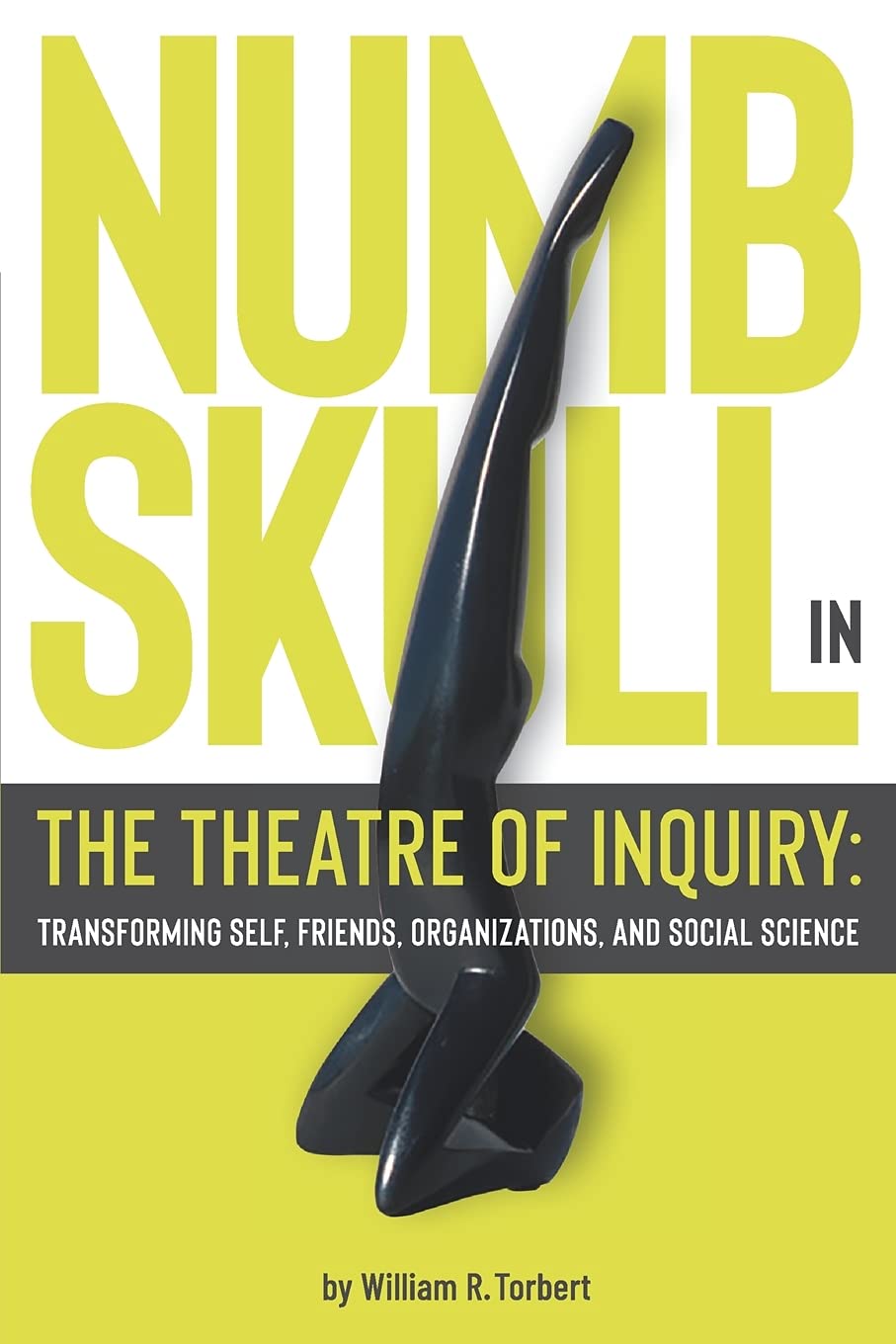
Halim Dunsky

Bill Torbert’s Numbskull in the Theatre of Inquiry is a delightful and thought-provoking volume. More than an engaging memoir, it offers a concise summary and practical illustration of the major models comprising Torbert’s life work. (Cardiff, CA: Waterside Productions, 2021; 476 pp., available at Amazon.)
The book is itself a work of praxis. Torbert has dedicated his life to the discovery and unfoldment of the kind of truth that can generate timely action—both within his individuated self and within the communities of the world that he has touched, contributed to, and in some cases created. In Numbskull he not only reviews that history, but continues to enact it, and with a disarming tone of serious playfulness. It’s suggested that the reader feel free to dip into the text initially at random, turning the reading itself into an action inquiry process.

Torbert is rare among academics in recognizing a continuity—or perhaps identity—between the work of practical mind, the work of scientific mind, and the work of spiritual mind. (This is a natural connection, as all three are in fact social activities that depend upon engaging a community of inquiry in the exploration of reality. One wonders why this is not more broadly recognized.) Bill has been a life-long student of the teachings of G.I. Gurdjieff, and is, of course, a prolific social scientist and a senior co-founder of the field of adult development. His work has often appeared and been cited in these pages.
Building from this orientation it emerges that Bill is not just a student but an activist focused on the transformational liberation of self and society in this co-arising, inter-independent world. In particular, he has long seen that survival and flourishing amid the challenges and threats of our complexifying times calls for increasing cognitive complexity and maturity, including the capacity to engage in collaboration to harvest the generative potential of collective intelligence. Bill’s work has been foundational in establishing that the skills and inclination to do this are not merely stylistic but developmental in origin. Fundamental to this work is his articulation of the developmental stages or Action-Logics through which cognitive-emotional-sensory capacity in individuals, organizations, and cultures can be seen to emerge. In Numbskull Torbert traces his own development through the action-logics as he recounts and considers impactful crises and passages in his own life.
What may be Bill’s signature contribution to the understanding of learning is expressed in the discipline he named Action Inquiry, the process through which we evolve through the action-logics (do see his iconic 2004 book of that title.) With Action Inquiry (AI), Torbert sets the inquirer squarely in the frame of action. This is more than “learning by doing” in the sense of practice. It is putting oneself and one’s perspectives on the line, and submitting to the transformative potential of curiosity and experimentation. The act becomes the question; the question, an act perturbing the system. Where conventional research is biased in favor of assimilation (the incorporation of the results of hypothesis testing into existing cognitive frames), AI appears to have a bias toward accommodation, in which the structures of understanding themselves are allowed (indeed, invited) to shift under the influence of new experience. In this respect, AI foregrounds the fluidity underlying the continuous work of the evolution of consciousness. (Bill sometimes uses the term “human AI” to distinguish Action Inquiry from Artificial Intelligence, the likely misnamed, if not oxymoronic, field whose initials it shares.)
Torbert has elaborated Action Inquiry in articulating the transdisciplinary social science research paradigm he calls Collaborative Developmental Action Inquiry (CDAI). With CDAI, Torbert takes a further step outside the fantasy of the disinterested researcher, to explicitly bring participation into discovery. More than the opposite of “unobtrusive methods,” this is deliberate engagement of researcher and community with subject. Further, it is expected that not only will understanding advance, but subject and researcher will mutually transform. And in what direction? In Torbert’s orientation, the gradient is toward an increase of conscious awakening, love, sustainability, and social justice. A substantial appendix sets out CDAI within a fascinating developmental framing of a range of such paradigms: Behaviorism, Gestalt, Empirical Positivism, Multi-Method Pluralism, Post-Modern Critical Interpretivism, Action Science Praxis, Cooperative Ecological Inquiry, and Collaborative Developmental Action Inquiry. The perspective offered across this set of approaches is remarkable.
Many authors have support communities who read and comment on an unfinished work; few invite them to contribute to an autobiography with passages in their own words. Yet, delightfully, this is just what Torbert has done here. He has broadened the parallax offered within his own writing by bringing in first person accounts and commentary—not always favorable—on passages in the book and in Torbert’s life. Many of Bill’s colleagues and former students have contributed in this way, notably in generating 1) the excellent Endnotes; 2) the Postscript, a set of first person accounts illustrating development and action inquiry practice in the life and voice of a Middle Eastern, Millennial woman of color, Aftab Erfan; and 3) Appendix A, which summarizes Torbert’s theories of learning and action.
Indeed, for a quick introduction or refresher on Bill’s theoretical work, you may want to start with Appendix A. There you will find, for example, a summary of what he has called the “Four Territories” of experience. Much as the Integral model encourages recognition and exploration of the quadrants of I/We/It/Its into which the aspects of any occasion can be parsed, so the model of the Territories advocates for inclusive consideration of 1) the outside world, 2) one’s behavior as sensed from within, 3) one’s internal cognitive-emotional-sensory structure, and 4) post-cognitive consciousness. Appendix A also reviews Bill’s powerful case for triangulating the benefits of inquiry conducted in the three persons: first person subjective, second person intersubjective, and third person objective. And this Appendix introduces the cybernetic frame of single-, double-, and triple-loop learning, or learning from past and present experience and future possibility.
In the late 70s, as also here retold, Bill and colleagues stepped briefly into the vibrant global community of experimental theatre. The Theatre of Inquiry offered a range of settings for individual and group discovery through role-playing, invention, and response, with participation blurring the distinction between actor and audience. In that setting and through the years, and on both sides of the footlights, as it were, Bill often stepped into the role of clown or jester as a way of destabilizing what was stuck, or of making the unconscious conscious. Apropos “both sides” and the arts, a younger, more supple and slimmer Torbert was in fact the model for the Peter Haines bronze that graces the cover of the book. (At my best, I never looked that good.) The figure alludes to one of the book’s more amusing stories.
Numbskull is a fascinating exploration of what love, inquiry, power, community, capacity, and purpose can look like as they evolve in richness along the developmental journey that is available to us all.
I encourage you to take the opportunity for a ride-along and meeting with this remarkable man as he unpacks his life experience for your contemplation and his own.
About the Author
Halim Dunsky supports the development of individuals and organizations through Full Presence Coaching, which he founded, and where he is enterprise consultant and executive coach. Halim’s career has spanned more than 40 years in commercial software, consulting, corporate IT, education, and community organizations. He has held a wide variety of leadership and technical positions in large global corporations, small organizations, and startups, and has started a consultancy and a small non-profit and co-founded a graduate school in Green Business. Halim also has a lifetime of practice in inner work and spiritual traditions including Subud, hatha yoga, bhakti yoga, meditation, psychotherapy, Authentic Movement, Sufism, the Dances of Universal Peace, and the Diamond Approach.
Halim holds an M.A. in Organizational Systems from Saybrook University, with a thesis titled Transitions in the Structures of Consciousness. He is an internationally certified professional coach (CPCC, ACC).
